Erstellt am: 21. 4. 2009 - 17:24 Uhr
Guerrilla Comm?
Ein leicht modifizierter Vortrag, den ich eigentlich für die SXSW-Konferenz in Austin geschrieben habe. Aber wäre ja zu schade den verkommen zu lassen.
As we all know, we live in an age that has been deemed the "Age of Communication". Calling it this has done us all a huge favour because now we know that it’s all about communication.And it is global communication we are talking about here. Global communication is organized and institutionalized by big machines that we call the ‘media’. Media is a word for lots of things that we need to communicate. There has always been media – such as our faces and hands which we frequently use to get something across to one another. (I don’t think I am an exception here. I use my hands a lot when I talk.) But for a couple of years now we have media enabling us to communicate over long distances. And this has massively changed our world as well as our reality. Now, our reality (say our houses and streets and towns and habits) is supplemented by far-away realities of far-away houses and streets and towns and habits. On Myspace we can have friends that might not even exist and we still keep befriending them and feel great about it.
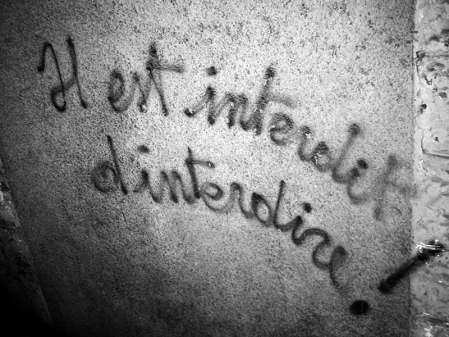
Creative Commons
As a result, our world has become bigger and smaller at the same time. This world wide world is no longer a world constituted by direct action in the way that, say, our garden is by our gardening efforts. Gardening the modern world means gardening the media. The garden we live in is a media garden in which we act and react. Every real world problem has to be represented in the media system to be real - or at least: to be real to us. Even if something might finally kill us like global warming will: the media has to tell us now that some such will happen then. So at least we shouldn’t act surprised while we’re croaking.
We all know and most of us probably understand that the major power of today’s world is the media. Whoever controls the media controls everything. And since the media is not nature but culture – Western culture that is - it is always owned by somebody. There’s no such thing as free media – no matter how deeply stupid liberals might yearn for it. Again: There’s no such thing as free media. Please call the police if someone steals your iPhone.

Police of Albuquerque, New Mexico
Media is always owned, I own some, you own some - but most of it is owned by … well… someone else. About 35% of the media is owned by Bill Gates as a recent study suggests that I asked my friend David to do on his lunch break. I gave him 20 bucks for his work. I offered him 25 if he could find that it’s actually 45%, but he said nobody would believe that and so we agreed on 35% for 20$. And now you understand why Bill Gates is called "Gates of perception".
So, now we recognize that media is the strongest political, economic and of course heuristic power in the modern world. And most of us do not own significant parts of it.
So if someone wants to do anything about it, he has to hack the system. And I know that you want to hack the system in order to add something to it – like your stupid marketing concept for your stupid product that you stupidly believe in. So what you need is a concept that’s called guerrilla communication. And I am about to tell you what that is and how it works as a way to help you put together the stupid marketing concept for your stupid product. To get on my stupid nerves afterwards. Dumb ass me!
I also know that you don’t want to change the world in general because you are living on the sunny side of it. That’s only natural and you won’t go to hell for it because there’s no such thing as hell to punish you for what you have been or done in your lives. I sometimes wish there was a God to beat you up in the afterlife for what you’ve done and been - but there just isn’t – you lucky bastards.
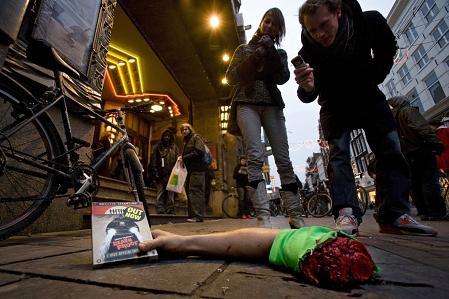
Creative Commons
Guerrilla communication intends to wage war on the media system and to wage war on a reality that is produced by this system… or even "system system". Using the word ‘guerrilla’ suggests that there’s a war going on. And it suggests that media tries to constitute and preserve the status quo. This is the status quo of a society in which knowledge and information are not only means of controlling people (as US-American-type liberals might fervently acclaim) but also to segregate people into classes like the working class and the networking class – that‘s you and me, by the way. (From a proud leftist perspective there is no real difference between conservatives and liberal ideology. They are both on the same side, fighting for the fluffy concept of “freedom". But in fact they are fighting to maintain their privileges of class, sex, race and birthplace. That’s why both sides fear the “government" like Satan fears Holy Water, because an entity like the “government" can actually cut down their privileges.)
So what can be done about it? How can you fight these powers which also make sure you can keep your privileges as the ruling knowledge elite? Let’s see what the classical guerrilla communication suggests here…
The determining factor of guerrilla tactics is to launch small but effective operations to attack an enemy which is much bigger but also a little lame due to a certain degree of formal institutionalisation. And these tactics are taken from classical guerrilla warfare (which already made use of plenty of guerrilla communication to disturb, confuse or interrupt its enemy’s communication system).
But there is a difference between military/paramilitary guerrilla and guerrilla communication strategies. The latter is not aimed at just overthrowing its enemy and to put the foot on its face and itself in its place. (That almost sounded like Dr. Seuss.) No! Guerrilla communication does not want to defeat mainstream media as a whole. It doesn’t want to exert capital punishment, genocide, suppression, or whichever classical male military intentions there might be else. And I suspect you little capitalist market-war info-soldiers that it is this which you are into. And that this is the reason why you are reading this, all keen to learn about guerrilla communication to return to your small, smelly office boxes to wipe out somebody who you feel is an unnecessary obstacle in your way to economic success. And I am sure you will read about covering mobbing communication right after this. Whatever.

D. Bracker
Unlike military guerrilla, guerrilla communication aims to interfere in the monologue of bourgeois mainstream media and to show how reality and normality are created by having control over the media and publicity and public spaces. It is inspired by various theories on social communication, how it works and how it works for those in power. It includes positions that tend to focus merely on the government (just like the liberal tradition) and excludes any other factors from the analysis, feeling no need for showing a more complex portrait of social powers. But guerrilla communication theories might also include more left-wing or Marxist positions pointing out that all power is derived from the social factors underlying and forming a society, such as class, race or sex. My position in this would of course be that normality and reality are created within such a structure. And that to attack normality and reality would also mean to attack this very structure - something which theorists have referred to as the semiotics of reality or social semiotics. In a media-based society (and of course there is no such thing as a non-media-based society consisting of more than one person) it is the signs and significants, the meanings and habits and conventions of speaking and thinking, the images and stereotypes which control everything. It’s what is represented, how it is represented and of course what is not represented or how it lacks representation. It’s not so much Rupert Murdock – whose assholeness I will not dispute – we should attack but rather something I would call the cultural grammar of the public space (which consists of the media space as well as of streets, places and baseball stadiums). Power is formed within such a grammar. Access und non-access to each and everything is regulated in its realm. Meanings are negotiated there. Good and evil are determined – bourgeois morale is defined as the morale of the ruling elite and then forced upon everybody else through bourgeois jurisdiction and prisons locking away those who won’t comply with their position in the social class-race-sex-structure. And of course this structure is not a free gliding and mystical pattern but merely the effect of class and race and gender management in society.
Guerrilla communication tries to understand the processes by which the media come up with social frameworks of behaviour and perception. And by understanding what’s going on here it also tries to introduce tiny symbolic changes to that system in order to make people suspicious of the information, wanting to understand the ideological structure and goal it transports. Guerrilla communication urges us to reconsider what we believe (and also what we believe to believe) and whom we do believe and why. Moreover, it tries to point out that media is forcing Gleichschaltung ("alignment") onto people, by censoring facts that don’t fit in the picture. And it tells us that information and the media should be free. Maybe one should mention Wikipedia in this context. But most of the people involved do not realise that there’s no such thing as free media in a capitalist bourgeois and liberal society. A free good on the free market would be either a nice gadget, a simple free-be, a marketing tool for something else or merely a paradox. If you disagree feel free to come up with an existing example which doesn’t fit in any of these categories.
There’s a wide range of strategies guerrilla communication could use: most of them have something to do with mocking or mimicry of official communication - with faking and rearranging it in the process. These strategies are useful in attacking a single player like a multinational doing the very wrong by trying to stain his image and tactically embarrass himself as a warning to stop the evildoing. While this rather useful strategy is pointing out the power of the public as buyers or not-buyers it still remains within the construct of "good and thoughtful capitalism fighting its evil twin". It doesn’t dig too deep under the surface of the media world. It’s like half-assed guerrilla communication and perfectly fit for a middle-class occasionally caring a little about caring a little about the worst and most unbearable effects of capitalism.

Billboard Liberation Front
Another strategy would be decoding information techniques and processes. The idea here is that publicity means to expose yourself and therefore you can be attacked. Advertising has to be placed somewhere in public and as soon as something tries to give instructions it can be obeyed or disobeyed by not playing by the rules. You could for example decide to not buy a specific product as long as it is advertised. This might become your personal and individual strategy of guerrilla communication. But it sucks because, unfortunately, it’s always the best products which are advertised because they are advertised. There is no such thing as free and individual taste. But advertising wants you to believe in the freedom and individuality of your taste which doesn’t even exist – empirically, that is.
You too can sabotage instructions by misinterpreting them and acting dumb. That goes for the factory workers who are of course excluded from a congress like this but also for you white collar supremacists: why not use the CD drive in your office computer as a coffee cup-holder? Ever tried it?! It’s got a tinge of freedom to it which you of course wouldn’t want to experience because it’s dangerous. It’s the freedom of something that exists beyond the mere functionality the way it was intended. Oh wait – are you a hacker?
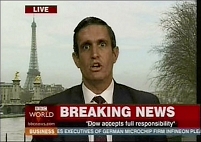
The Yes Men
Anyways, one of the basic strategies has to be faking things: press releases by political parties or companies, even websites like the one the Yes Men did – one of the most famous guerrilla communication group of our time. Via the fake websites they receive correspondence from other players on the information market and even invitations to speak in the name of the company they pretend to be part of. One of their biggest hoaxes was a BBC-World interview as a Dow-Chemical-spokesman at the 20th anniversary of the Bhopal toxic gas accident in India resulting in 3.000 deaths and 120.000 injured and still suffering badly from the effects. Dow Chemical who is in charge of the responsible company Union Carbide always refused to pay compensation for the case. But Yes Men activist Andy Bichlbaum - under the name of Jude Finisterra - claimed during this interview that Dow Chemical was finally willing to take responsibility and pay 12 billion dollars – shortly afterwards Dow Chemical repudiated while their stocks had begun to fall rapidly.
To sum it up you could say that it’s all about playing with representation and identity, with alienation and identification. At least through over-identification which means that you use affirmation to a degree that goes far beyond what is conventional in order to show what something really means - but also to act out the habits and conventions of your enemy. Guerrilla information, for example, uses classical marketing tools and knowledge in exactly the same way it is always used, but twists it in the opposite direction. This works for press releases and interviews as well as for personal habits, like what you wear and how you look. The Yes Men, for example, are masters of the typical company spokesmen body language and tone of voice, so what they do can no longer be called a parody (even if they use parody and satirical points) but is rather an impersonation.
You could call this strategy the illegitimate occupying of speaking positions in a world in which some people and players have more power to speak and a louder voice than others. While classical counter-culture media could hardly ever have such an effect on the public due to its natural limitations, hijacking or faking the channels and speaking positions means to get messages out with a lot more power and urge.
So you could say that guerrilla communication is not trying to destroy the dominant codes but rather to deconstruct and strategically abuse them. And of course to use them for its own purposes.
Now we understand that guerrilla communication doesn’t have a military goal like destroying and overtaking anything or suppressing and overruling anybody or exterminating a special group of people. It’s more about bringing a special group of people like the people of Bhopal on the map of global consciousness. Most of the time guerrilla communicationists are not so much concerned about themselves. But I am also sure that the media attention for themselves as well as a possibility of upgrading their human capital as ethical rebels and skilful pranksters adds a lot of motivation. Interesting, isn’t it?
To sum it up, guerrilla communication is a versatile practice of cultural resistance.
The earliest forms of modern guerrilla communication are to be found within the WWI art scene, when a group of international artists and deserters met in Zurich on neutral Swiss ground to launch the Dada movement. Dada was the precursor of modern and post modern radical art movements such as The Situationist International, Punk or Neoism. A major concern of Dadaist art was to cut in on old forms of artistic activities such as painting pictures or writing lyrics. Instead, they were looking for new forms of art to fit into the modern world. They started out as noise mongers with pretty radical performances. Soon they began to manipulate the press by distributing fake press information. In a way, Dadaists worked with the media like other artists work with paint or metal. They also cut and re-cut pictures, words and lines from newspapers and assembled collages and montages out of it, sometimes of grotesque and sometimes of political content. Later on, they launched interventions in the public space attacking major institutions of post-war society. The so-called "Oberdada" (chief dada) Johannes Baader – one of the first performance artists of the 20th century – managed to confuse the attendants of a church service at the Berlin cathedral by reading out his own bizarre sermon. He also threw leaflets entitled "The Green Corpse" down from the gallery at the German National Assembly. By doing that he catapulted Dada right into the bourgeois media.
These interventions broke ground for a lot of late modernist art and sub-cultural strategies attempting to model the public space or the social world rather than holding on to classical art stuff such as painting pictures or sculpturing.
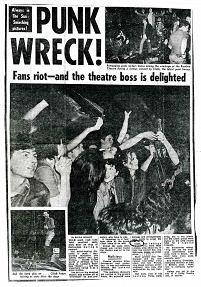
The Sun, 1977
A vast group of social drop-outs emerged during the high times of Western counterculture - from the Beatniks to the Punk movement. These people developed strategies to provoke and challenge society, to implement their political agenda into the public space and to start reclaiming the streets – jut like a slogan has it. The street is synonymous for public space and the humdrum surface of society. Therefore, it was considered the perfect stage for informing people or, let’s say, for counter-informing people. Most activists came from a classical art or journalist background but had experienced that nobody really listens when you speak in the traditional art space. Your average guy does not go to exhibitions, concerts nor does he get in touch with counter culture media. Counter culture and the art world are niche places. And even if people would go there they would consider what happens there to be "just art". Art is the place where things might be reflected. But that amounts to nothing because it is not linked to everyday life. Art is a special task and a special place for special people. Something the elite are involved with, by buying its high-priced products of criticism. This is the classical drama of bourgeois art in bourgeois society – same is true for bourgeois journalism: it simply keeps embodying the same old role as a critical sidekick of the powers to be. The shiny good cop to its bad cop-ness. It does a good shoe shining job within a system that neither opposes nor represses it, but generously grants art and literature and journalism to feel free to criticize and to complain.
Around the 1960s, a lot of strategies emerged to confront the men and women in the street right where they were to escape the bourgeois art world’s limitations. The first happenings were staged referring to Dada and a lot of street theatre groups popped up everywhere. Street theatre ranged from conventional plays acted out amidst the shoppers and passers-by to role plays where the audience did not even realize they were watching a play. The post-bourgeois artists were trying to bring the art back to the people – not as a handy service (as it is to the bourgeois elite art consumer) but as a form of irritation. This was one of the many starting points of guerrilla communication. And also of the so called ‘reclaim the streets’-movement which includes funny yet irritating activities like Flashmobs – as well as the Adbusters’ Movement.

Adbusters
To "adbust" means to bust and destroy advertisements and other inscriptions in the public space that epitomise the vulgar capitalist idea the there’s no such thing as a public space but only private spaces belonging to those who buy or rent them. Everybody is an adbuster - at least sometimes - because everybody has busted advertisements in his life. You can for example bust a billboard if you park your car in front of it blocking it from view for a while. Or your dog might pee at it. And if the internet is public space, too, you can block pop-ups – the possibilities are endless. So there’s a great variety of adbusting techniques and only a small percentage might get you into serious trouble with the law. More severe interventions include pasting over advertisements, tearing them off, graffiti-ing or otherwise commenting on them, rendering them impossible, changing the messages or the like. These are not necessarily very refined ways of attacking the ads but rather spontaneous expressions of disgust and frustration with advertisement in general or a specific ad – one displaying, for example, racist or sexist images. If you take into account that the average person receives up to 3.000 advertising messages every day, as a recent study had it, you will understand that advertisement causes aggressions and frustration and the need to let off steam at least from time to time.
In the 1970s, counterculture split into a more traditional Marxist wing consisting of small parties and groups that wasted a lot of their precious time and beautiful youth to fight each other. It was a less dogmatic movement which was called "Spaßguerrilla" – fun guerrilla, that is – or the ‘Sponti-movement’ to emphasise its spontaneous and site-specific character. Plenty of the activities which were conceived at that time - like throwing pies at celebrities – are still around in the guerrilla communication movement of today. They too started working with so-called fakes – fake information and actions distributed via the bourgeois media oblivious of the fact it was spreading a hoax. A popular slogan had it that the basic idea was to ‘invent false facts in order to create real events’ (= Die Erfindung falscher Tatsachen zur Schaffung wahrer Ereignisse) But they too made real object fakes and did cultural piracy stuff like pirate editions of the socialist classics or handing out well-faked subway tickets. Pirate radio stations – like the famous Radio Alice in Italy – appeared and hijacked radio frequencies. Graffiti was an important weapon of that movement to overwrite the text of the city. And in its best and most far-out moment they came up with the post-modern idea that social structures are texts, too, and therefore can be overwritten in the same way you can overwrite an advertisement. At the same time the squatter’s movement emerged. These were post-bourgeois artists in the very literal sense of the word, attacking actual private property as well as non-material cultural property. So, the good thing about guerrilla communication is that – unlike everybody else - it shows no respect for the fact that the media and the public space are always owned and in the hands of the bourgeois elite and semi-elite. As are the images and cultural frameworks we live in. And its central and basic strategy is to misappropriate images, words, radio frequencies and shift them to different contexts. In France, the famous and influential Situationist Movement defined a form of art called ‘détournement’. It means that you roam aimlessly around the streets of Paris – or Paris, Texas -- and take what you find and then do something with it.

Autonome A.F.R.I.K.A Gruppe
A lot of these activities were and still are strictly illegal. Therefore, guerrilla communication activists had to develop forms of camouflage and hiding away behind multiple names and open pseudonyms – like in the Luther-Blissett-project. In the meantime, a detective novel bestseller was published under the name, plus lots of other books and readers on the matter of cultural subversion and jamming – for example by the German guerrilla communication group ‘Autonome A.F.R.I.K.A Gruppe’. Pseudonyms don’t just grant invisibility for people avoiding the blame; they also let you get away with violating the bourgeois principle of identity as a person, as an artist, or as an author. The person is – so they say – a nation within in the nation (= Staat im Staat). And that is why some people try to overcome it by forming collective personae. The Luther Blissett activists demanded everybody to edit their works exclusively under the name of Luther Blissett.
So, in a certain way, guerrilla communication is a lot like hacking. And hacking is, of course, one of the means of guerrilla communication, because it is a hostile assault from outside the system trying to find a way into the system to change or manipulate it from within. And to do so, you have got to know how everything works, so, first you need to understand the way in which the media shapes and constitutes reality - just like hackers know what a website is and how it works. And that is to say: not simply what a website looks like and how you can find it in an ocean of websites, but also how the code works.
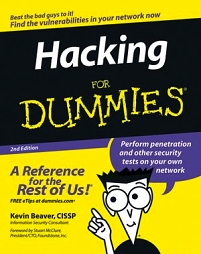
For Dummies
Actually, you’ve got to dig deep into the code to then be able to manipulate it. Every one of you will probably know what a web programming code is or you will at least have some idea of it. And most of you probably even are aware how technological code constitutes the media. But what do we know about the cultural code of messages? Do we really understand how, for example, hetero-sexism is cemented in our society via texts and images? And what about cultural stereotypes? How do we – or at least some of us – come to believe that white males from suburbs are meant to rule the world without even once spending a thought on it? How is the sexist and racist and classist sub consciousness of the liberal society shaped trough the media and access to it? Any suggestions? You sure won’t have any because it is just the nature of the capitalist and bourgeois constant flow of ever the same images and stories and pictures. And that is what’s got to be hacked and changed to make it visible and questionable. Only once something can be seen will we realise what has been invisible before. That’s why we need to hack the media flow to bring on some different images and ideas – to hack into media and change its message flow and the stereotypes it communicates.
But that of course should by no means be the ultimate of what we are up to.

monochrom
As long as you simply play around with the media - even as a media pirate and/or hacker - you are still part of the system. You have to change the political economics of a society, I say. And you can quote me on that. Otherwise, we will just be going round and round in the same old circles as the history of guerrilla communication clearly shows. Looking back at the guerrilla communication movement, we have to say that beside the counter-culture intentions these strategies were an early form of viral marketing for the rebels themselves or at least for some of them. Because a great part of the movement has made it to the top of our society and its institutions – like the former German minister of foreign affairs, Joschka Fischer, who has been among the notorious players of the huge Sponti-movement in Frankfurt before turning into a complete butthead. So it is all about success; and success is what you are up to, aren’t you? So will you do me a favour and at least erase all the information I gave you from your memory. Maybe not sharing the information would be the utmost guerrilla communication act. Or at least it would make a slightly better world.
I don’t know.

